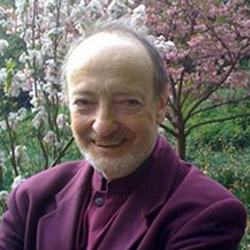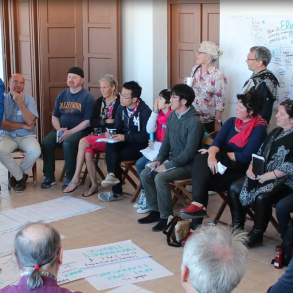By George Pór, excerpted from a paper originally published at academia.edu and in Spanda Journal Vol. 7, 2017, p. 15.
To support collective awakening at a requisite scale, action research must be conducted in expanding, cumulative circles of involvement. To address that requirement, I initiated the development of the Generative Action Research (GAR) methodology (Pór, 2014a).
The concept of “generativity” has been used in social sciences in various ways, starting with Erickson, who applied it to labeling the stage of a psychosocial development, when “the concern in establishing and guiding the next generation”2 appears.
Gergen writes about the “ideal of generativity, in which theory serves the dual role of undermining convention and providing refreshing theoretical alternatives”3. In a key paper, Schön talks about “generative metaphors” as metaphors that help us gain new perspectives of the world4.
“The word generativity appears frequently in the Appreciative Inquiry literature in phrases such as generative dialogue, generative metaphor, and generative inquiry. In this context, the use of the term generativity is often inspired by Gergen’s argument for the creation of ‘generative theory’ – theory that challenges the status quo and opens new repertoires for thought and action5.”
More recently, voices in the AR Plus collective further redefined the concept: “Generativity stretches the meaning of sustainability from survival into more lofty aspirations. …
[A] promising expanded definition of sustainability as ‘the possibility that human and other forms of life will flourish on the Earth forever’ takes our responsibility for sustainability beyond the human group, it extends our temporal horizon and it awakens our yearning to create a future reality that is not available yet […]
When we take a generative stance, we ask what might be the noblest possibilities for human existence on earth and we commit to engage with one another and the larger world in relational processes that bring those possibilities within reach6.”
My GAR methodology (Pór, 2010) shares that stance of generativity and is deeply resonant with “our cooperative capacity to reunite seeming opposites such as theory as practice, the secular as sacred […] Inquiry is the experience of mystery, moving beyond the edge of the known to the unknown, which then changes our lives7.”
Generative Action Research is also inspired by the work of Thomas Hübl, another author of this issue, [of the original article on Spanda Journal] who is “exploring the relationship between outer science and inner experience with the focus upon active engagement with the global challenges facing humanity in today’s post-modern society8.”
At the end of each section, you will find a set of sample questions aimed at contributing to the design conversation for any GAR initiative that the section may trigger. They are mere conversation openers that I offer with the understanding that each cycle of inquiry and action will feed the next cycles with questions growing out from the previous ones.
Before diving into exploring the scales of collective awakening, let’s re-focus on the concept of “generativity.” My use of that term distinguishes from, transcends, and includes its uses by most of the traditional and AR and Appreciative Inquiry literature. Its main distinguishing feature is the set of attributes grounded in the evolution of natural systems, where they are described with the processes of gathering, repeating, sharing, and transforming9.
Generative capabilities manifest in a group of any size (including humankind itself) in a way that permits it to continuously improve its ability to evolve. The four generative capabilities essential in collective awakening are:
SELF-SUSTAINING
Balancing change and continuity in a way that supports the life-enhancing, future-responsive forces of the organization.
~ Creating a robust and agile collective “nervous system:” a foundation of innovation and sustainability.
~ Developing and using collective sensing and meaning-making organs, and a shared memory.
For a system or method to be self-sustaining, it needs to attract (gather) uses and users.
SELF-IMPROVING
Intentionally and continuously improving individual and collective effectiveness by:
~ Setting the action/assessment/feedback/learning loops so that they provide an improvement-supporting infrastructure.
~ Learning to generate new capabilities, then generalize them throughout the system.
For a system or method to be self-improving, it has to repeat the attraction process until a sufficient number of elements allow new combinations that improve it.
SELF-EVOLVING
Consciously searching for listening to an evolutionary purpose (Laloux, 2014) and higher forms, e.g.:
~ A corporation dedicated to serve the common good (including future generations) has a higher purpose than one which focuses only on stockholder value.
~ Organizing forms designed to foster trust, truth-telling, collaboration, self-reflection and creativity are higher forms than those that perpetuate patterns of fear, scarcity, secrecy, and control over people.
For a system or method to be self-evolving, its elements need to be able to freely interact with each other (share) so that emergent evolution can occur.
SELF-PROPAGATING
Embodying the core idea in a way that inspires others to awaken new possibilities in their lives,
relationships, and organizations, through, e.g.:
~ Being a source of learning and experience for others; consciously spreading innovative practices worth replicating.
~ Participating in evolutionary learning communities that both learn and teach.
For a system or method to be self-propagating, it has to facilitate its replication and transformation in an entirely new developmental cycle.
These are the four generative qualities
that a well-designed Generative Action Research must provide if its objective is to foster transformative, collective awakening at all four scales (micro, meso, macro, and mundo).
That can be achieved only in consultation and partnership with local and collective actors and their participation in the expanding circles of involvement.
While this essay outlines only the need and possibility for such research, if and when this research, highly significant to our common future, attracts the resources needed for its deployment, it will no doubt contribute not only to collective awakening, but also, to the theory and practice of Generative Action Research.
I started this paper by exploring how I am part of the collective process and how it is also part of me. That kind of self-reflexivity is a hallmark of awakening communities, and it should also be the hallmark of the small community of action researchers forming around this project.
PóR, G. (2014a). Issue paper for the workshop on Collective Intelligence for the Common Good (CI4CG)<bit.ly/2rVggWg>. [Retrieved on May 16, 2017].
1 ATLEE, T.(2003). “Crisis Fatigue and the Co-Creation of Positive Possibilities”, <http://bit.ly/2qZWJFT> [Retrieved on May 27,2017]
2 ERIKSON, E. H. (1950, 1963). Childhood and society. (New York: Norton).

George Pór is an evolutionary thinker and a strategic learning partner to visionary leaders in business, government, and civil society. He is the originator of Enlivening Edge and teaches a course on “Transformative Communities of Practice” at Meridian University. A select list of his articles and book chapters on the fields of collective intelligence, organizational and social renewal can be found here.
Republished with permission.
Featured Image/graphic link added by Enlivening Edge Magazine from klimkin at pixabay.com




